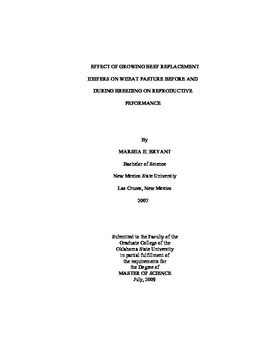| dc.contributor.advisor | Horn, Gerald W. | |
| dc.contributor.author | Bryant, Marsha H. | |
| dc.date.accessioned | 2014-04-15T20:12:39Z | |
| dc.date.available | 2014-04-15T20:12:39Z | |
| dc.date.issued | 2009-07-01 | |
| dc.identifier.uri | https://hdl.handle.net/11244/8796 | |
| dc.description.abstract | Unsatisfactory breeding performance has been reported when replacement heifers have been exposed to bulls or AI while grazing small grains. The objective of this study was to compare reproductive performance of heifers grazing wheat pasture before and during breeding with heifers grazing wheat pasture until approximately 3 weeks before breeding. In each of two years, 40 spring-born Angus and Angus crossbred heifers were placed on wheat pasture in December and randomly assigned to one of two treatment groups in mid March. Group one (WP; n=20) remained on wheat pasture (mean CP 26.6 %) through estrus synchronization and fixed-time AI (FAI). Group two (DL; n=20) was placed in drylot and had free choice access to a corn-based growing ration (11.1% CP) through estrous synchronization and FAI. Heifers were exposed to fertile bulls 10 d after FAI for 45 d. Conception after FAI was determined at 32 d post-AI by ultrasonography. Five weekly blood samples starting 5 wks before FAI were obtained to describe luteal activity prior to estrous synchronization and for analysis of urea-N concentrations before and during estrous synchronization and FAI. Reproductive data were analyzed using the PROC GLIMMIX procedure of SAS. Concentrations of urea in plasma or serum, and insulin like growth factor-I were analyzed with the mixed model procedure of SAS with year and sampling block as random variables. The percentage of heifers with luteal activity was 75% and 55% for WP and DL, respectively (P = 0.08). Drylot heifers were heavier than WP heifers (408 vs. 394 kg ? 4.49) at the time of AI (P < 0.01) but were similar (P = 0.43) when final body weight was measured on native range (417 vs. 414 kg ? 5.26). Conception rate to FAI was similar (P = 0.38) for WP (53%) and DL (43%) and final pregnancy rate was similar (P = 0.34) for WP (98%) and DL (95%). Concentrations of urea were less (5.77 mg/dL vs. 29.15 mg/dL, P < 0.01) for DL heifers during all weeks after treatments were imposed. Reproductive performance of heifers grazing wheat pasture during estrous synchronization and FAI was similar to heifers consuming a corn-based growing diet in drylot. | |
| dc.format | application/pdf | |
| dc.language | en_US | |
| dc.publisher | Oklahoma State University | |
| dc.rights | Copyright is held by the author who has granted the Oklahoma State University Library the non-exclusive right to share this material in its institutional repository. Contact Digital Library Services at lib-dls@okstate.edu or 405-744-9161 for the permission policy on the use, reproduction or distribution of this material. | |
| dc.title | Effect of Growing Beef Replacement Heifers on Wheat Pasture Before and During Breeding on Reproductive Peformance | |
| dc.type | text | |
| dc.contributor.committeeMember | Selk, Glenn | |
| dc.contributor.committeeMember | Wettemann, Robert Paul | |
| dc.contributor.committeeMember | Lalman, David | |
| osu.filename | Bryant_okstate_0664M_10448.pdf | |
| osu.college | Agricultural Sciences and Natural Resources | |
| osu.accesstype | Open Access | |
| dc.description.department | Department of Animal Science | |
| dc.type.genre | Thesis | |
